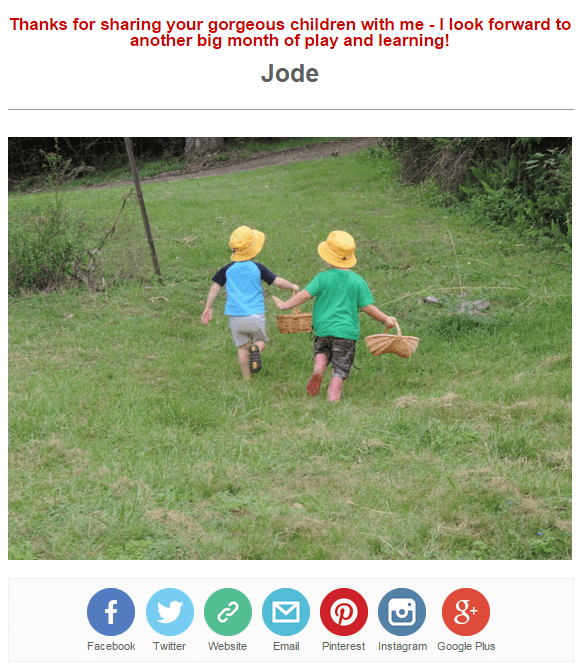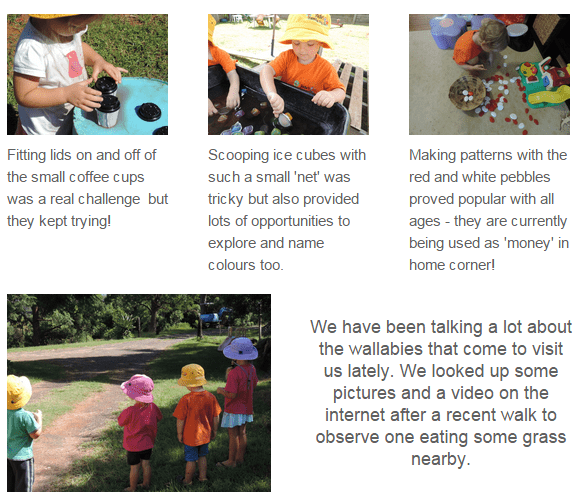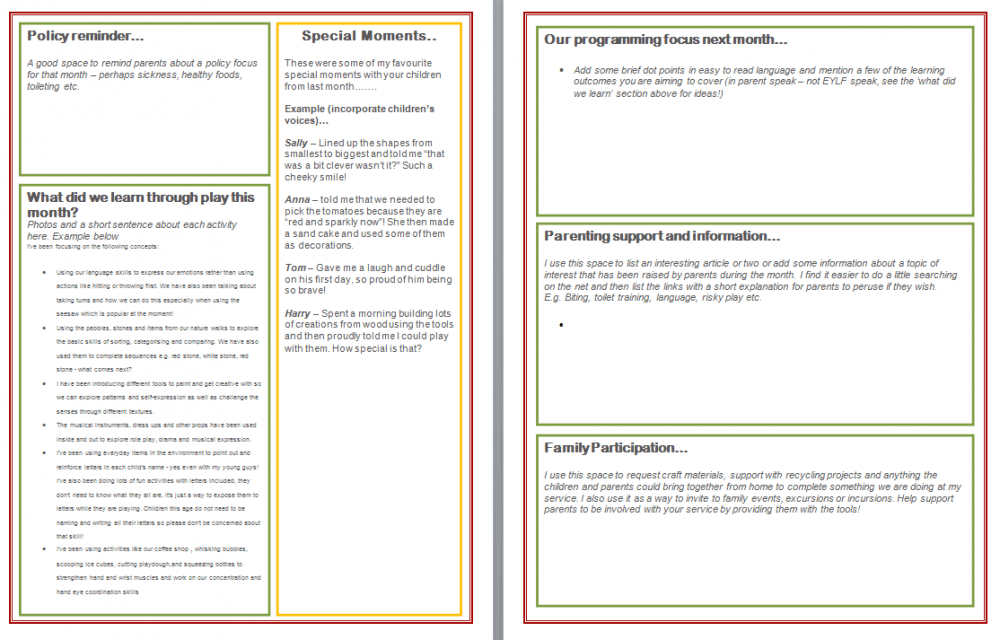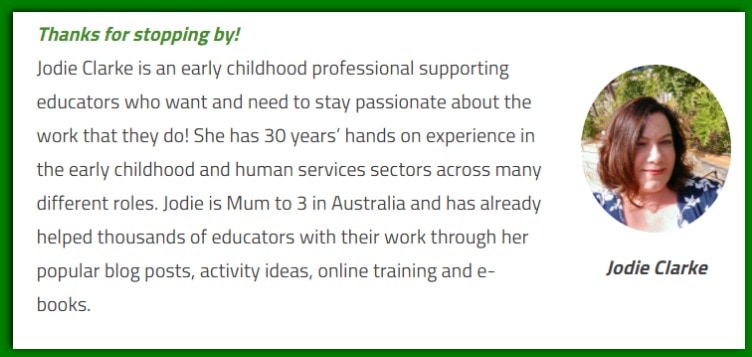Newsletters are a fantastic way to share your early childhood service’s activities, events and children’s learning journeys and interests. But they need to be done well or they won’t be read. Parents are busy, educators are busy so it makes sense to ensure your newsletters are an effective use of everyone’s time and won’t just be thrown into the too hard basket.
Here are my top tips for writing interesting and effective newsletters for parents.
Make a personal connection.
Start your newsletters with a personal note from the person running the service. Even if you don’t see every parent across a week (especially if a director of a large centre) it’s important to reach out and connect when you can. Parents and carers are more likely to come to you to discuss an issue, become involved in the service or offer positive feedback if they feel you are interested and not just the person running the show.
Over the years I have found starting my newsletters with a section ‘From Jode’s desk’ gets me in the right frame of mind to start writing about the past month. It doesn’t need to be lengthy; just a few snippets about what’s been going on behind the scenes and what you hope to achieve across the next month.
Try to reach out to parents with the way that you share your information, help them to feel involved and part of the service.

Keep it as visual and as easy to read as possible.
Use photos to convey what’s been happening in the last month. Photos are easier for busy readers to scan quickly and if you add a small amount of text explaining what the photo shows you are providing more information to come back to when there is more time.
The example below is from an electronic newsletter I now send out. It makes it very easy to drop photos into the template but it is just as easy to insert them into a word document.
Use large headings, bullet points and highlighted text to appeal to the readers who like to skim and pick out important points. I always add photos to my newsletters, the more the better. If you are printing your newsletters you will obviously want to use less.

Proofread and then proofread again.
There is nothing worse than a newsletter coming from educators that has spelling and grammar mistakes. Ensure that you have a few eyes look over the newsletter before you send it out.
Include elements of children’s ‘voices’.
Educators often ask me how they can incorporate children’s voices into their programming as this is a requirement of the EYLF (Australian early years learning framework) I incorporate their voices into my weekly and daily parent communication but newsletters are also a fantastic strategy for achieving this outcome.
There are many ways to do it. You can use something like the template below…I usually add some photos on the right and then a few quotes from the children relating to each photo.

If you work in family day care and therefore have fewer children you might like to do something like my example below in the box ‘Special Moments’…this is easy to do and can also link to your observations and programming if you wish, just add the newsletter date to your program.

Provide links to further reading and resources.
If you email your newsletters (and frankly I would hope most of you are – especially with the current focus on sustainability)then it is easy to add some links for parents to follow for further reading and information when they have the time. It is also a good way of involving staff in your newsletter if you are working at a large centre. Ask each staff member to do some internet research about a topic of interest in their room from the previous month, they can then come back with a relevant and useful link and explain why they feel it would be beneficial for parents to click through.
Perhaps as an educator, you have noticed a common interest emerging among your group of children – why not use links and a short explanation to support parents to extend their child’s interest in this area at home.
I also use this method to direct parents to recipe and lunchbox ideas as well as simple activities from blogs online that they might like to try with their children at home.
If you still print a hard copy then please be wary of adding too many ‘factsheets’ for parents to read…if it looks like hard work to get through then it probably won’t be read anyway. It would be a better use of your time to summarise the factsheet and provide relevant footnotes.
Share what the children have learnt through play.
One of my favourite sections to include in a newsletter. As educators working with children every day it is easy to forget that not everyone understands that play is a child’s ‘work’ and actually forms the very basis of their learning.
Keep this in mind when writing for parents. Help them to understand how the play their children have been engaging in throughout the past month has been contributing to their individual learning journeys. You don’t need to cover everything obviously, just pick a few of the standouts and aim to explain simply the possibilities that evolved from the play.
If parents better understand the play and learning their child is involved in they are more likely to be able to extend and incorporate interests and play into their everyday living at home.
The example below is from a recent newsletter of mine…

Use your language effectively – not to show off your knowledge.
It is tempting when sharing your activities and learning with parents to use educator terminology to ensure they understand the importance of what you have been offering to their children. Keep in mind that parents are busy people but they love to know what their child has been doing so share it in terms they can easily understand and identify with.
You might incorporate some language of the EYLF if you feel it appropriate but steer clear of listing a whole lot of outcome numbers and educator jargon!

Give parents/carers a reason to be involved with your service.
Include a section in your newsletter that highlights opportunities for parents to be involved with your service. You might ask them to bring recycled materials in for craft, some photos from family weekends, bags to take home scraps if they have chickens, materials from their workplaces for outdoor/dramatic play, invitations to family events at your service….you get the idea.
They won’t always have time to chat at drop off and pick up times but if it is written down for them to read and consider when they do have the time you are likely to get a much better response and participation rate.
Make your reminders and requests count!
I like to include a section for important reminders and requests (or ‘pleas for mercy’ as I secretly call them). This section is quite direct and to the point. It is a good place to give a reminder about what to bring to care, healthy lunchbox options, excursion dates, late fees, administration requirements and anything else that has been a source of stress that month!!
I also sometimes include a section for ‘policy reminders’ if I feel parents need a refresh on appropriate policy and procedure. Keep it brief but break it down so easily understood quickly – dot points are most effective.
Keep it regular.
Try and keep a rhythm and purpose to your newsletters without being overzealous. I aim for one at the end of each month and it doesn’t always happen, sometimes it becomes bi-monthly but my parents always know there is one coming. If you run a large service it is also helpful for staff to know a date each month when they are required to submit their room wrap-ups or news.
Find out what works best for the service you work in but then try to stick with it so parents are aware of what to expect…and when.

Provide links to the local community.
Incorporate information relating to the local community. It might not directly link to your service but if it is something that might be of interest to your families then you are helping them connect to their community by providing information and dates to be aware of.
Go digital.
Emailing newsletters not only saves a whole lot of paper and ink but you can also go nuts with the inclusion of photos, fonts and colour highlights to really make your newsletter look professional and stand out. It also saves a lot of time that might have been wasted on printing, collating and delivering. Simply put together an email list of all parents attending your service and ask if they would prefer to receive their newsletter electronically. Using word, publisher or a similar program of your choice simply create a blank template you can save to reuse over and over again. Drop your content in each month, convert to a pdf format and then hit send! Done!
Show parents what their money is being spent on.
I like to share photos of new resources and equipment in action. Don’t be afraid to show off the purchases you have been making and how the children have been using them or benefiting from them. Same goes for any landscaping work or new areas you have developed.
This was a section shared in one of my digital newsletters.

I hope you are now feeling inspired to take another look at your newsletters or perhaps even begin sharing one!



hi Jode i am an educator too and I am inspired with your work
I feel a bit isolated and love to get new resources or craft ideas , songs finger games anything that s spark the creativity of the moment
cheers laura
Hi Laura, thanks for your kind words. So sorry you are feeling isolated…it can be so easy to feel that way in this job unfortunately!I hope you continue to find inspiration here – I share lots of creative ideas on my Facebook page too which might be helpful 🙂
I love your website. Thank you for all the help. I have been in family day care for 12 years but an always looking to jazz uo my newletters and investigate new ways of leanring and teaching children.
Thanks so much Gail, we are always looking for new ideas no matter how long we have been in the game I think that’s for sure :)That’s the mark of a good educator…always willing to learn something new to pass on !
Love the ideas and thanks for your kind support
I absolutely loved this blog post! The tips on crafting engaging newsletters are incredibly helpful, especially the emphasis on making content relatable for parents. I can’t wait to apply these strategies in my next newsletter. Thank you for sharing such valuable insights!